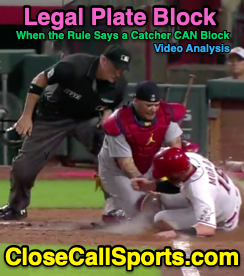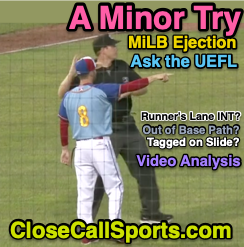For this
Teachable Moment, we find ourselves in Chattanooga as the Double-A Lookouts host the Pensacola Blue Wahoos. We're following umpires James Jean, Raul Moreno, and Macon Hammond as they officiate baseball's vaunted "fourth out" appeal play during the top of the 8th inning of a 5-3 ballgame.
Play: With one out and runners at the corners (R1, R3), Blue Wahoos batter Bubba Hollins hits a fly ball to Lookouts center fielder Mike Siani for out #2, who throws home to catcher Daniel Vellojin well after Blue Wahoos baserunner R3 Cobie Fletcher-Vance has crossed home plate as runner R1 Davis Bradshaw tags up from first base and attempts to advance to second. Catcher Vellojin then throws to shortstop Matt McLain, who tags R1 Bradshaw for the third out of the inning.
After the third out, Chattanooga's fielders initially start to jog toward their dugout, but then stop while still in the infield. Shortstop Matt McLain then throws the ball to third baseman Christian Encarnacion-Strand, who steps on third base to appeal that Pensacola R3 Fletcher-Vance left early. HP Umpire Raul Moreno agrees and emphatically calls Fletcher-Vance out on appeal, thus applying the fourth out to the inning and wiping the run off the board.
Analysis: Because leaving a base early on a caught fly ball (technically "failure to retouch a base" in a timely manner [e.g., after the fielder's first touch of the batted fly ball on a catch]) is an appeal play, it can occur after all the action for the play has already transpired. For instance, we usually see appeals occur after the play in question (but before the next pitch is thrown), and this situation is no different. Baserunner R3 Fletcher-Vance is still on the hook for leaving early (failing to timely retouch).
Fourth Out potential also means we're dealing with a
Time Play scenario. Time plays—which are plays in which umpires may be called upon to determine whether or not a leading runner touched home plate before a trailing runner was declared out for the third out of the inning (that is not a force out)—are possible whenever a third out can be recorded on a play wherein there exists any number of baserunners, which, when added to the number outs to start the play, equal three or greater. In this situation, play began with
one out and
two runners aboard. One plus two equals three and, accordingly, this is a potential time play. Time play situations are also possible fourth outs, and this possibility manifested here.
Official Baseball Rule 5.09(c): "Appeal plays may require an umpire to recognize an apparent “fourth out.” If the third out is made during a play in which an appeal play is sustained on another runner, the appeal play decision takes precedence in determining the out. If there is more than one appeal during a play that ends a half-inning, the defense may elect to take the out that gives it the advantage."
Accordingly, the out on Fletcher-Vance (via appeal) thus became the true third out of the inning and, pursuant to OBR 5.09(c), R1 Bradshaw's out at second base is disregarded.
Video as follows:














